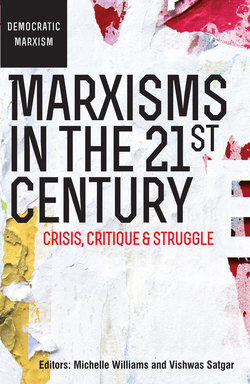Читать книгу Marxisms in the 21st Century - John Saul - Страница 16
На сайте Литреса книга снята с продажи.
Marxism as an Evolving Tradition
ОглавлениеIf Marxism is an evolving tradition, what do all its varieties share that make them part of that tradition? What makes Marxism Marxism? What is its abiding core irrespective of the period, irrespective of the national terrain? What do all branches of Marxism have in common? If we think of the Marxist tradition as an ever-growing tree, we can ask: What are its roots? What defines its trunk? What are its branches?1
The roots themselves grow in a shifting entanglement of four foundational claims: historical materialism as laid out in the preface to the Critique of Political Economy, the premises of history as found in The German Ideology, notions of human nature as found in the Economic and Philosophical Manuscripts, and the relation of theory and practice as found in the Theses on Feuerbach. The trunk of the Marxist tree is the theory of capitalism, presented in the three volumes of Capital, and revised by inheritors over the last century and a half.
Then there are the successive branches of Marxism – German Marxism, Russian-Soviet Marxism, Western Marxism, Third World Marxism – some branches dead, others dying and yet others flourishing. Each branch springs from its own reconstruction of Marxism, responding to specific historical circumstances. German Marxism responded to the reformist tendencies within the German socialist movement of 1890–1920 as well as capitalism’s capacity to absorb the crises it generates; Russian Marxism sprang from the dilemmas of the combined and uneven development of capitalism on a world scale, and of the battle over socialism in one country; Western Marxism was a response to Soviet Marxism, fascism and the failure of revolution in the West; and Third World Marxism grapples with the dilemmas of underdevelopment as well as colonial and post-colonial struggles.
When we examine this tree we see that Marxism may have begun as a small-scale project that did indeed link people across national boundaries – think of the First International. As classical Marxism garnered popular support it became tied to national politics (Russian, German, French and so on) from which it expanded into regional blocs – Soviet, Western and Third World Marxism. What is the scale of Marxism today? Even though its popular base has shrunk, I will argue that Marxism can no longer respond only to local, national or regional issues; it has to embrace global issues, issues that affect the entire planet. To reconstruct Marxism on a global scale requires, I argue, rethinking the material basis of Marxism through the lens of the market, but not in terms of its geographical scope (since markets have always been global as well as local), nor even in terms of neoliberal ascendancy (since markets have always moved through periods of expansion and contraction) but in terms of the novel modes of commodification.
In brief, there have been three waves of marketisation that have swept the world: the first spanning the nineteenth century, the second beginning after World War I and the third beginning in the mid-1970s. Associated with each wave is the commodification of a leading force of production, successively labour, money and nature. These are Karl Polanyi’s (1944) three fictitious commodities whose commodification, he claimed, destroys their use value. Thus, when labour is subject to unregulated exchange it loses its use value – it cannot be productive; if money is subject to unregulated exchange the value of money becomes so volatile that businesses go out of business; and if nature is turned into a commodity it destroys our means of existence – the air we breathe, the water we drink, the land upon which we grow food, the bodies we inhabit. Each wave of commodification spawns a countermovement that is built on a distinctive set of expanding rights (labour, social and human) organised on an ever-widening scale: local, national and, presumptively, global. Finally, to each countermovement there corresponds a distinctive configuration of Marxism – classical Marxism based on the projection of an economic utopia; Soviet, Western and Third World Marxism based on state regulation; and finally, sociological Marxism based on an expanding and self-regulating civil society.
The periodisation of Marxism may be tied to the periodisation of capitalism but the periods themselves are continually reconstructed as a history of the evolving present, a history that makes sense of the present as both distinct from and continuous with the past. Marx (1967) saw only one period of capitalism, Lenin (1963) saw two and Ernest Mandel (1975) saw three. We, too, see three, not based on production but rather on the market as the most salient experience of today. Here I do, indeed, break with the conventional Marxist claim that production provides the foundation of opposition to capitalism. This is no longer tenable: in part because production is the locus of the organisation of consent to capitalism, and in part because in the face of the global production of surplus labour populations, exploitation is rapidly becoming a sought-after privilege of the few. Exploitation continues to figure centrally in the dynamics of accumulation, but not in the experience of subjugated populations. In the Marxian analysis the experience of the market appears as the ‘fetishism of commodities’, a camouflage for the hidden abode of production, but it is much more than that, shaping multiple dimensions of human existence.
